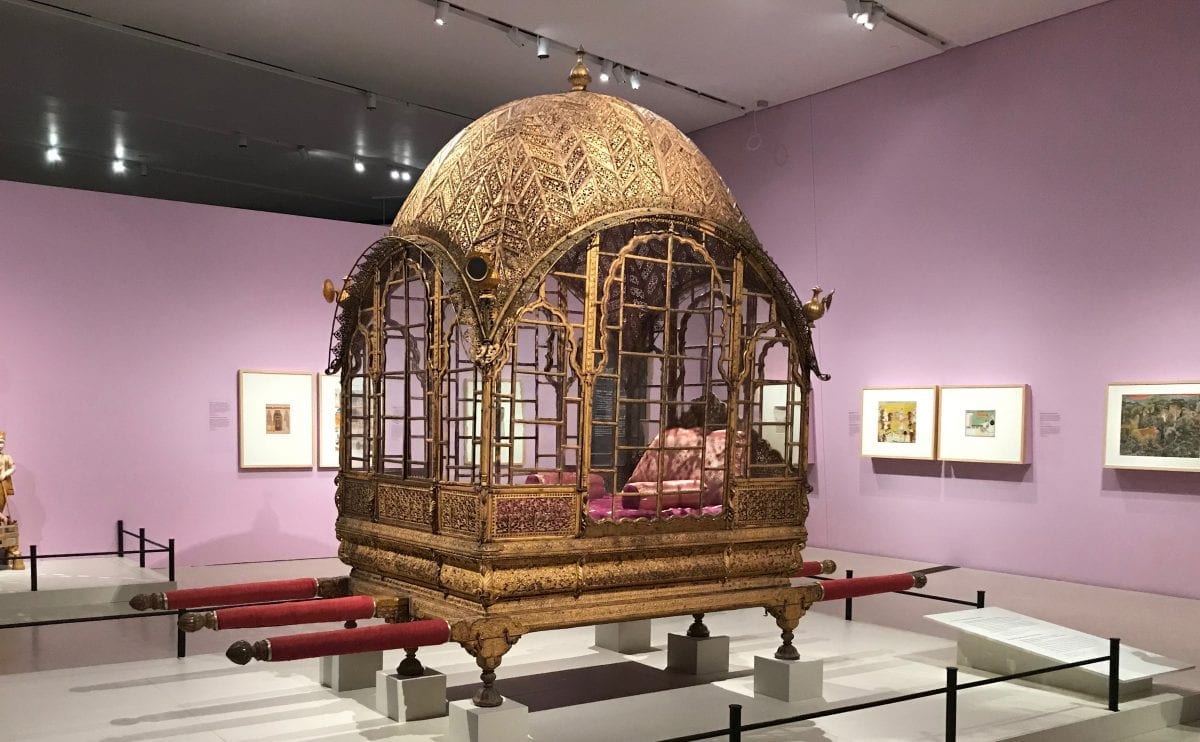
‘Treasures Of A Desert Kingdom: The Royal Arts Of Jodhpur, India’ Dazzles At The Royal Ontario Museum
Lifestyle Mar 11, 2019
The Royal Family of Marwar-Jodhpur opened their vaults to reveal an exquisite collection which is on display in a limited international run. With the only Canadian stop in this North American tour, Treasures Of A Desert Kingdom: The Royal Arts Of Jodhpur, India dazzles at the Royal Ontario Museum.
When Lieutenant General Sir Pratap Singh (who was also the Maharaja of Idar and Regent of Jodhpur) was travelling to attend Queen Victoria’s Golden Jubilee in 1887, little did he know that a slight hiccup during his journey would also anoint him as an innovator of fashion. At first, he traversed by ship before docking in Cairo so he could continue his travels on land. The ship steamed forth along with his luggage while Singh only kept his riding gear with him. The ship, along with its cargo—and the luggage—sank leaving him without any formal wear. Once he arrived in London he connected with a tailor. Speaking very little English, he laid on the table one of his riding breeches (which was a shalwar type of pant that had ties around the bottom half of the leg to keep the fabric from connecting with the saddle) and pointed to it said “Jodhpur”.

And that is how the Jodhpur pant came to be. As relayed to me by his descendant, His Highness Maharaja Gaj Singh II of Marwar-Jodhpur with whom I had the pleasure of chatting with during the exclusive preview of the Royal Ontario Museum’s (ROM) expansive exhibit. The exhibit formally opened its doors on March 9th and will do so until September 2, 2019. Singh along with his daughter Princess Baijilal Shivranjani Rajye of Marwar-Jodhpur came to Toronto to celebrate the Canadian leg of this globe-trotting exhibition.


The stunning showcase which spans six centuries of Indian history boasts nearly 250 pieces from the former kingdom of Marwar-Jodhpur including various furnishings, artwork, textiles, cultural artifacts, ceremonial objects, jewels, tapestries and a pristine 1920s Phantom Rolls-Royce, which have all been carefully plucked from the Royal Family’s private collection in Jodhpur.
To put it in proper historical context, the 15th century was an impressive era of global development. While the Royal Mehrangarh Fort was being built in Jodhpur, Italy was busy with creation of The Vatican, while China was making The Forbidden City come to fruition. To say India’s regal stamp in history was during a remarkable time would be an understatement.
The genesis of this exhibit started approximately three years ago when The Museum of Fine Arts, Houston reached out to Mehrangarh Museum Trust of India eager to put together a unique display of cultural contributions specific to this state’s royal history. After India’s initial hesitation about logistics subsided (as having a collection of this magnitude come directly from India to North America was a rarity due to the distance), it launched in February 2018 to critical acclaim. The exhibit then caught the attention of Seattle Art Museum which became its next stop before crossing the 49th parallel to come to Toronto—its only Canadian and final North American stop before heading to Prague at a later date before all the items return home to Jodhpur.


“This focus on a single princely state adds a level of history and depth which is important,” Noted Dr. Deepali Dewan the exhibition’s coordinating curator and ROM’s Dan Mishra Curator of South Asian Art & Culture. She explains how this showcase differs from past royal-themed presentations. “They aren’t objects taken from India and put in western museums. These aren’t objects where you can just go down to LA or NYC to see. This is directly from India. These are pieces that are still part of the Jodhpur royal family since the beginning.”
The five connecting presentation spaces, which majestically ebbs and flows from one to the other at the ROM’s Garfield Weston Exhibition Hall, creates a foundation for a unique experience for the visitor. The pieces (of which many of them are being seen outside of the royal courts for the first time) are strategically positioned to reveal the many layers of royal society specifically from the arts and culture space, telling a thematic story of alliances, the power of the royal women and how the arts were skillfully used as tools for diplomacy from the 15th century to the present day.
“They are all put together to tell a story. That’s what we wanted to project” explained Singh. “There is history. There is continuity. The descendants still exist. Its evolution is a part of the Indian story.”



Exploring the country’s royal history also calls for recognizing the country’s post-independence journey of self-discovery, where for a long while the idea of looking back was seen as way of jeopardizing the nation’s progress. “[The common opinion] was that the past held us back. Forget it. Move forward. It was all about industrialization. Instead of learning about our own history we were learning about what was going on in the world.” Singh explained how the importance of recognizing his country’s royal history dawned on him during his time in England where he studied. “I realized that here we have modern industrialized states, and they still had monarchies and they protected their art and culture and made an asset out of it. That’s why I got involved when I came back [to India]. People of India realized that we have rejected our heritage for too long. And we need to pay attention to it because it gives it our identity and recognition all over the world.”
Princess Baijilal Shivranjani Rajye was also impressed at how the presentation of her family’s heirlooms exuded a more approachable ambience and not a “distant” one. She, like her father, appreciated the value of telling a specific story, different from past broader royal exhibits. “I think people saw it as decadent and playful and light. But there is so much more to that. There is this beauty that came out of the reality. The Mughals came to our country. They didn’t come to loot it, but they came to assimilate. When Rajput and Moghul culture assimilated beautiful art came out of it. And when the British came, yes that’s a complicated history, but look at the beauty of it. That’s what people have to look at, their beauty, not just the conflicts.”

Dewan also wants the visitor to venture past the glittering façade. “I hope they get more than just a view of stereotypical India. I am conscious of that fact that “Royal India” is what people know more of. I want that to be the door that hopefully brings people in and once they walk through it they actually find things that are more surprising such as the fact that Jodhpur has one of the longest continuous royal lineages in the world. The Royal Family of Jodhpur should be just as well known as the Royal Family of England.”


On a personal note, this exhibit surprisingly held more meaning for me than I had anticipated. I have known Deepali for many years especially during the seven years as the Chair of Friends of South Asia (a ROM volunteer-based committee that was created to promote South Asian installations at the ROM before and after the construction of the Sir Christopher Ondaatje South Asian Gallery). One of the more memorable public events we held was a salon-type of installation entitled Raj to Aaj. It still holds a special place in my heart to this day as it was one of the highest attended committee-led events at the ROM. And it was also great fun to organize. When Deepali was describing the five spaces of this current exhibit, she specifically wanted me to see the title of the final space. Why? Because it’s called Innovation and Continuity from Raj to Aaj. “See? You are part of this exhibit!” she exclaimed. And I laughed. Because not only did I have a chance to experience such a novel presentation, but it also served as a full circle moment for me as well.
Treasures Of A Desert Kingdom: The Royal Arts Of Jodhpur, India runs now until September 2, 2019. For ticket info please visit www.rom.on.ca
Main Image Photo Credit: Hina P. Ansari
Hina P. Ansari
Author
Hina P. Ansari is a graduate from The University of Western Ontario (London, Ontario). Since then she has carved a successful career in Canada's national fashion-publishing world as the Entertainment/Photo Editor at FLARE Magazine, Canada's national fashion magazine. She was the first South Asian in...













































































































